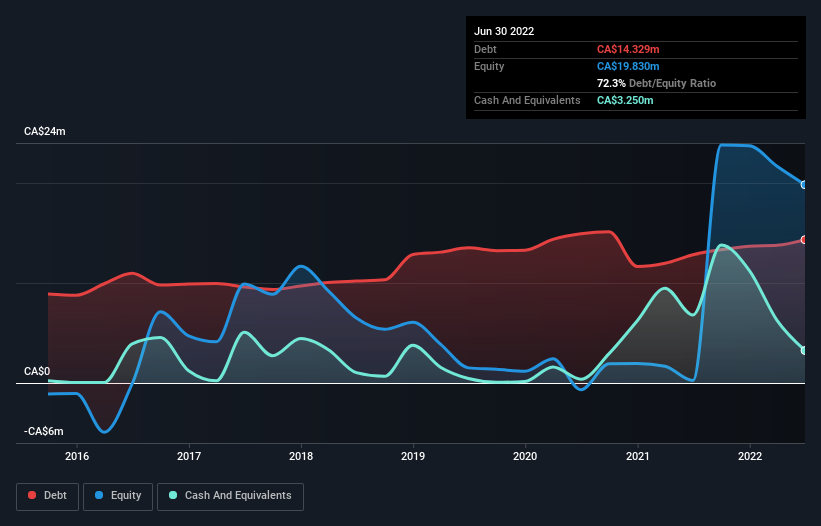
Legendary fund manager Li Lu (who Charlie Munger backed) once said, 'The biggest investment risk is not the volatility of prices, but whether you will suffer a permanent loss of capital.' So it seems the smart money knows that debt - which is usually involved in bankruptcies - is a very important factor, when you assess how risky a company is. As with many other companies Sabre Gold Mines Corp. (TSE:SGLD) makes use of debt. But the real question is whether this debt is making the company risky.
What Risk Does Debt Bring?
Debt is a tool to help businesses grow, but if a business is incapable of paying off its lenders, then it exists at their mercy. In the worst case scenario, a company can go bankrupt if it cannot pay its creditors. However, a more common (but still painful) scenario is that it has to raise new equity capital at a low price, thus permanently diluting shareholders. By replacing dilution, though, debt can be an extremely good tool for businesses that need capital to invest in growth at high rates of return. The first thing to do when considering how much debt a business uses is to look at its cash and debt together.
View our latest analysis for Sabre Gold Mines
What Is Sabre Gold Mines's Debt?
You can click the graphic below for the historical numbers, but it shows that as of June 2022 Sabre Gold Mines had CA$14.3m of debt, an increase on CA$12.8m, over one year. However, it does have CA$3.25m in cash offsetting this, leading to net debt of about CA$11.1m.

A Look At Sabre Gold Mines' Liabilities
Zooming in on the latest balance sheet data, we can see that Sabre Gold Mines had liabilities of CA$1.70m due within 12 months and liabilities of CA$34.4m due beyond that. Offsetting these obligations, it had cash of CA$3.25m as well as receivables valued at CA$239.2k due within 12 months. So it has liabilities totalling CA$32.6m more than its cash and near-term receivables, combined.
Given this deficit is actually higher than the company's market capitalization of CA$28.5m, we think shareholders really should watch Sabre Gold Mines's debt levels, like a parent watching their child ride a bike for the first time. Hypothetically, extremely heavy dilution would be required if the company were forced to pay down its liabilities by raising capital at the current share price. When analysing debt levels, the balance sheet is the obvious place to start. But you can't view debt in total isolation; since Sabre Gold Mines will need earnings to service that debt. So if you're keen to discover more about its earnings, it might be worth checking out this graph of its long term earnings trend.
Since Sabre Gold Mines has no significant operating revenue, shareholders probably hope it will develop a valuable new mine before too long.
Caveat Emptor
Importantly, Sabre Gold Mines had an earnings before interest and tax (EBIT) loss over the last year. Indeed, it lost a very considerable CA$5.1m at the EBIT level. Considering that alongside the liabilities mentioned above make us nervous about the company. We'd want to see some strong near-term improvements before getting too interested in the stock. Not least because it had negative free cash flow of CA$8.0m over the last twelve months. So suffice it to say we consider the stock to be risky. When analysing debt levels, the balance sheet is the obvious place to start. But ultimately, every company can contain risks that exist outside of the balance sheet. Be aware that Sabre Gold Mines is showing 6 warning signs in our investment analysis , and 4 of those can't be ignored...
If you're interested in investing in businesses that can grow profits without the burden of debt, then check out this free list of growing businesses that have net cash on the balance sheet.
New: Manage All Your Stock Portfolios in One Place
We've created the ultimate portfolio companion for stock investors, and it's free.
• Connect an unlimited number of Portfolios and see your total in one currency
• Be alerted to new Warning Signs or Risks via email or mobile
• Track the Fair Value of your stocks
Have feedback on this article? Concerned about the content? Get in touch with us directly. Alternatively, email editorial-team (at) simplywallst.com.
This article by Simply Wall St is general in nature. We provide commentary based on historical data and analyst forecasts only using an unbiased methodology and our articles are not intended to be financial advice. It does not constitute a recommendation to buy or sell any stock, and does not take account of your objectives, or your financial situation. We aim to bring you long-term focused analysis driven by fundamental data. Note that our analysis may not factor in the latest price-sensitive company announcements or qualitative material. Simply Wall St has no position in any stocks mentioned.
About TSX:SGLD
Sabre Gold Mines
Engages in the exploration and development of mineral properties.
Low and slightly overvalued.
Market Insights
Community Narratives





